BOx Large Format DIY Printer
-
Hi everyone,
First post here, I thought I'd present my machine first because I think I might have a few questions about how to use/improve/pimp my duet board later.
So, basically my goal is to build a big printer. So far the print volume measures 720 x 720 x 600 mm or so. The frame is made out of 4545 aluminum extrusions, it is entirely my design but I did build a MPCNC before, which was my inspiration for making this one, hence the tubes.
Anyway, this is my first time using a Duet, my other machines were using the traditional Arduino Mega/Ramps/Marlin, which worked nicely but, well, they did their time. So far I'm pretty pleased with how the Duet board works, it is really convenient to use, though editing the firmware is maybe a bit less intuitive since you use gcode all along instead of commenting/uncommenting stuff in a more understandable language. But I guess I'll get used to it eventually.
But again, the list of upsides is long enough that I don't really care about that, this board is awesome so kudos to the team who designed it.I started this build 2 months ago and it made its first test print yesterday. Here is how it looks like so far:
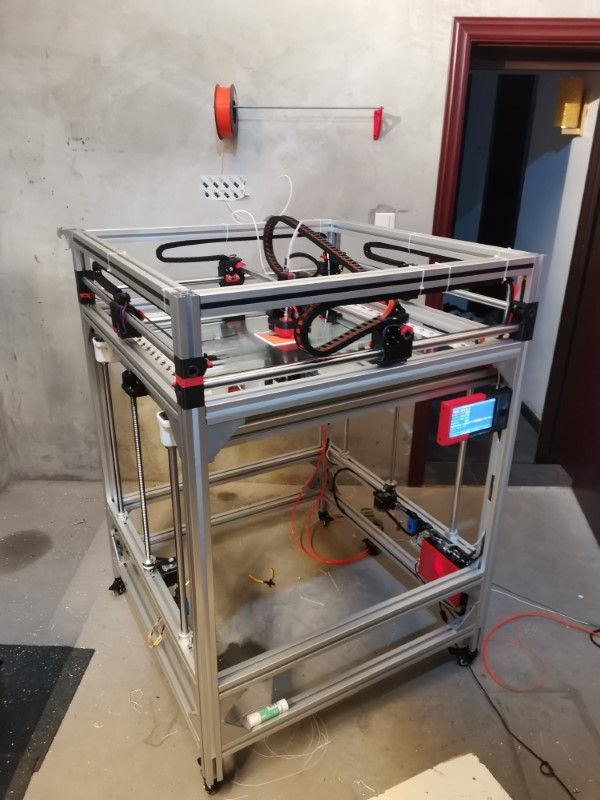
The machine itself measures 1m x 1m x 1m40 so it takes quite some space in the shop. The bed is made of a big 10 mm plate of cast aluminum. It will be heated by 9 silicon pads of 300W each, so about 2700W of heating power (goal is for the plate to reach the temp quickly). I'm currently using the double Z axis feature, which works well, but I'll probably add the extension board and go for triple Z axis later.
The bed is very heavy (30kg), but the motor have enough power to lift it pretty quickly, it takes less than 30 seconds to travel the 600+ mm which is actually quite impressive to see IRL since the machine is big. I had to go to 8 microstepping in order to do that reliably, but it doesn't matter in terms of resolution since I'm using a 3:1 belt reduction as well as 4mm per turn pitch ballscrews so in the end that's 1200steps per mm, way more than necessary.
The print head is water cooled, because from my experience it makes a big difference on large format printers. I've designed a fully 3D printed nozzle system using just a regular E3Dv6 extrusion system. So far it seems to work well. That's not the first watercooling system I designed this way, my previous one lasted a few years without any issue so I know this works well

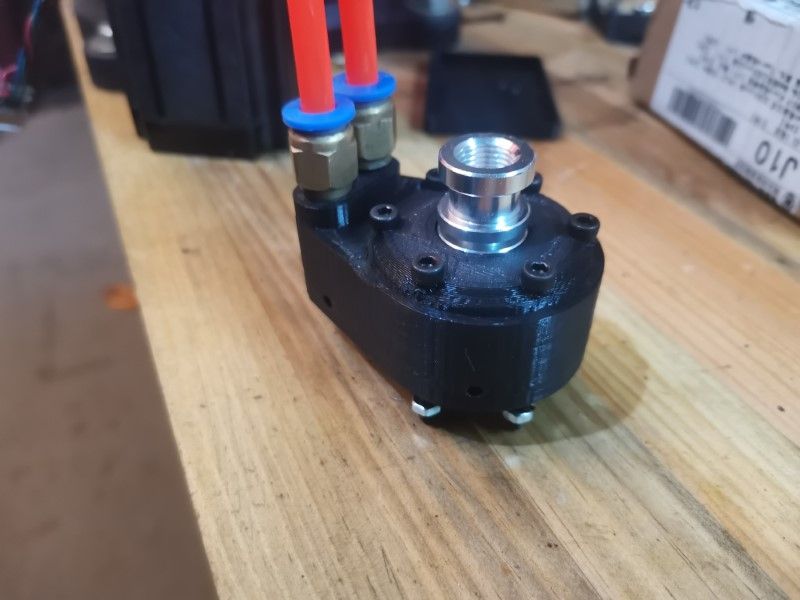
The heating block is a full copper volcano with a stainless steel nozzle, insulated with aerogel sheets.
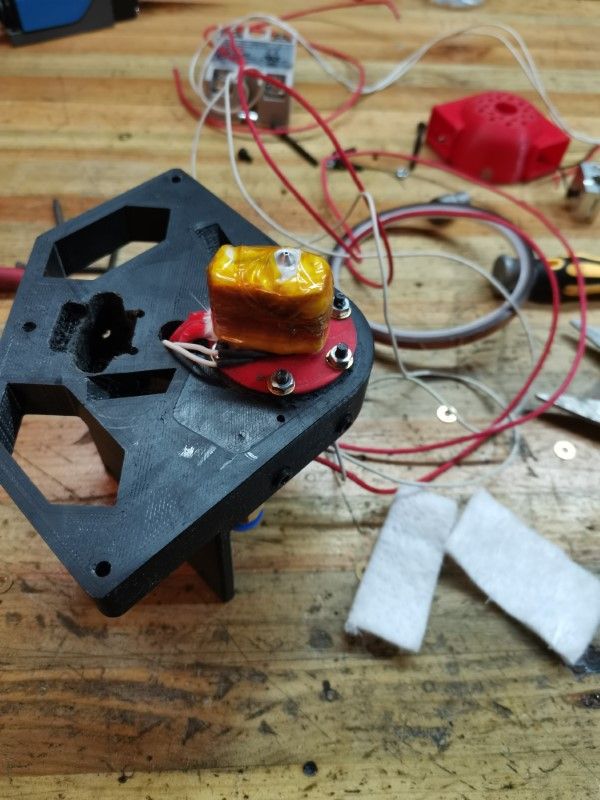
The part cooling fans are blowing 360 degree around the nozzle to hopefully avoid any blind spot. The aerogel insulation is very useful here because otherwise the fans would cool the hotend, which obviously wouldn't be ideal
The Z probe is using a BL touch.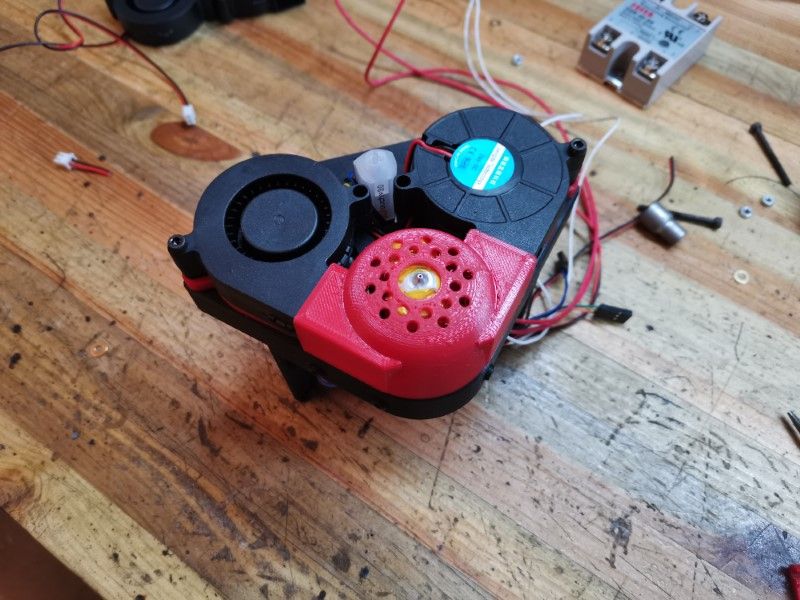
Also added a LED strip to better see what's going on during printing:

I took a lot of care designing a nice casing to protect my marvelous Duet board, since it deserved it:
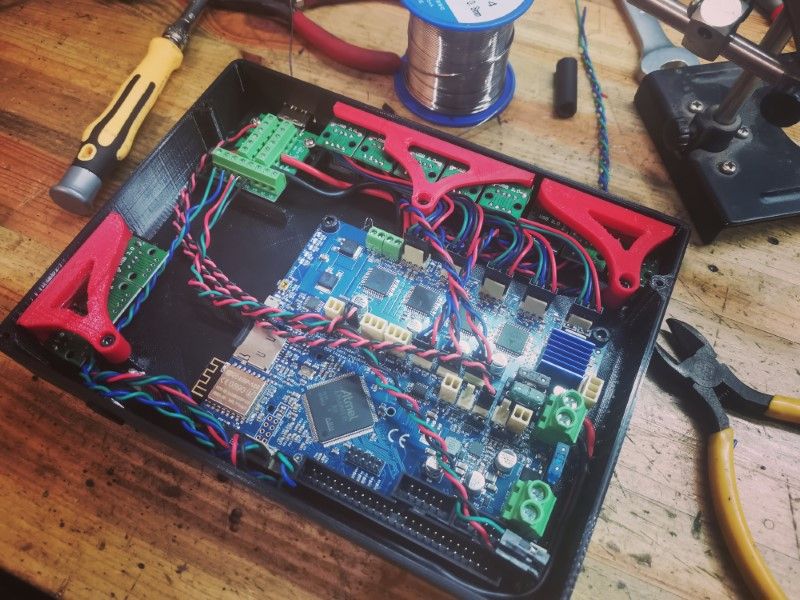
It features active cooling with a blower fan placed after a dust filter:

I needed active cooling because the Z drivers were running too hot, the bed is heavy so I had to push the motor drivers up to 2.4Amps.
I tried to be original here and used something unorthodox for wiring: using USB and HDMI cables. USB is used for the motors, the endstops, the paneldue and the heating bed relay control, and HDMI is used for the whole print head (heating element, temp sensor, BLtouch, extruder motor, LED light, fans).
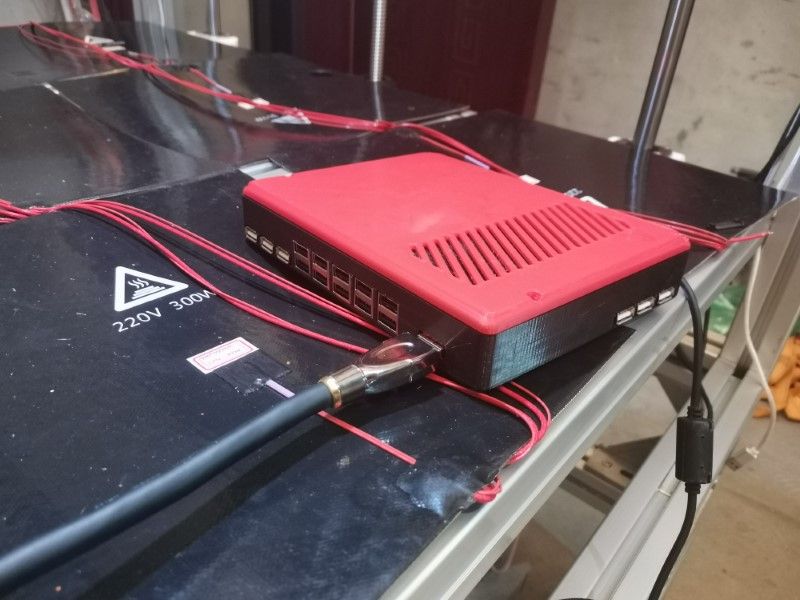
It makes wiring extremely easy, and so far it seems to work really well. I'll see in the long run how reliable this is, now is a bit too soon to give a proper feedback.
Anyway, first successful print attempt yesterday and it looks really nice for a first try:

Also a short video of the first print:
https://youtu.be/mw_b87EWHZkHere is the build thread, in case anyone wants to follow

https://forum.v1engineering.com/t/mpcnc-made-in-china-new-build/19393I'm really pleased with my Duet so far, it's a great board!
Thanks for reading and see you on the forum! -
Clever use of HDMI cables. I've seen that used in retro game controller adapters. HDMI cables are cheap, standardized, shielded, armored, and can be had in pretty much any length. Only downside is that they are not locking.
Very interesting hotend design. Well done.
-
@Phaedrux behold:
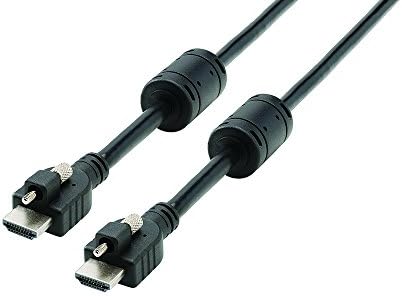
-
@oliof don't start with that nonsense

As an aside have you seen this great twitter thread of foone going slowly insane going down a clickhole of crazy USB cables:
https://twitter.com/Foone/status/1143299580445937665
@MrDui sorry for going off topic on your thread. the printer looks
 and yes, HDMI cables are a surprisingly good way to connect things, did you get the breakout boards off the shelf or make them yourself?
and yes, HDMI cables are a surprisingly good way to connect things, did you get the breakout boards off the shelf or make them yourself? -
@T3P3Tony said in BOx Large Format DIY Printer:
@MrDui sorry for going off topic on your thread. the printer looks
 and yes, HDMI cables are a surprisingly good way to connect things, did you get the breakout boards off the shelf or make them yourself?
and yes, HDMI cables are a surprisingly good way to connect things, did you get the breakout boards off the shelf or make them yourself?No problem, and thanks for the kind words

I've got the breakout board off the shelf, as it turns out it's easy and cheap to find, these things are used for home cinema application, they put these in wall plugs.I don't know in which country you live, I'm in China so I can't recommend you a store, but a quick search on Google shows them available on Adafruit here: https://www.adafruit.com/product/3121
It is really super convenient to use for a print head since you can just wire everything in a few minutes, only downside being that the HDMI cables are usually pretty thick and not super flexible.
-
The breakout board to HDMI looks very slick. I've wondered why something like that isn't done more often, is there a simple way to tell what the current limit would be on the HDMI and USB cables?
Regarding your motion system, what is driving your X and Y axes? I don't see belts, is there some sort of friction wheel on your rods?
-
@tgarr said in BOx Large Format DIY Printer:
Regarding your motion system, what is driving your X and Y axes? I don't see belts, is there some sort of friction wheel on your rods?
It is belt driven, each roller has its own stepper so that's two per axis, wired in parallel.

-
@tgarr said in BOx Large Format DIY Printer:
The breakout board to HDMI looks very slick. I've wondered why something like that isn't done more often, is there a simple way to tell what the current limit would be on the HDMI and USB cables?
This depends on the internal wire gauge used. I chose to go for 24AWG because I was concened to pass about 40W to the heated cartridge, but I think this might be overkill since I'm running the duet at 24V so that's only 1.5 amps, plus that's only full power for a few minutes during the initial heating anyways. But my cable is very long, it measures 5 metersso I had to lower its resistance by having a bigger section.
The lower the gauge, the less flexible the cable will be, which might be an issue on smaller printers. In my case it was already an issue, so I decided to remove the external PVC insulation of the HDMI cable and replaced it by a nylon sleeve so it would be easier for the cable chains to bend.The HDMI cable has around 20 indivudual wires, so you can also parallel some of them if you're concerned about power delivery. I didn't want to do that since I wanted the possibility to add a few accessories later, so I prefered to keep as much wires available as possible. Right now I've still got 3 or 5 wires still unused, that's after having wired the extruder cartridge, the temp sensor, the part fan, the LED, the Extruder motor and the BLtouch.
-
@MrDui said in BOx Large Format DIY Printer:
The higher the gauge, the less flexible the cable will be, which might be an issue on smaller printers.
Minor correction for anybody not aware: The higher the gauge, the THINNER the cable will be. A 32 gauge wire will be thinner than a 24 gauge wire and all else being equal will be MORE flexible.
I do like the idea of using HDMI cables though. It can really clean up the wire mess that seems to be unavoidable under most circumstances. Too bad I didn't think of that in my last printer build. -
@jens55 said in BOx Large Format DIY Printer:
@MrDui said in BOx Large Format DIY Printer:
The higher the gauge, the less flexible the cable will be, which might be an issue on smaller printers.
Minor correction for anybody not aware: The higher the gauge, the THINNER the cable will be. A 32 gauge wire will be thinner than a 24 gauge wire and all else being equal will be MORE flexible.
Oh yeah you're absolutely right, I made a mistake in writing my post. It's corrected now, sorry for the confusion!
-
@MrDui said in BOx Large Format DIY Printer:
the less flexible the cable will be, which might be an issue on smaller printers. In my case it was already an issue, so I decided to remove the external PVC insulation of the HDMI cable and replaced it by a nylon sleeve so it would be easier for the cable chains to bend.
HDMI cables are potentially not designed for continual flexing so it will be very interesting to see how these hold up pver long periods of use. I am using one to the toolhead on my toolchanger (for an Raspberry Pi Camera) and so far that has worked well but i am half expecting it to fail at some point.
-
@MrDui thanks for the close up. That clarifies quite a bit for me.
May I ask what drove the decision to package the belts and motors this way? It looks like you essentially made a rack and pinion setup from a belt. Seems pretty cool. And comments on how it performs relative to stationary motors or a metal rack and pinion?
-
@tgarr said in BOx Large Format DIY Printer:
@MrDui thanks for the close up. That clarifies quite a bit for me.
May I ask what drove the decision to package the belts and motors this way? It looks like you essentially made a rack and pinion setup from a belt. Seems pretty cool. And comments on how it performs relative to stationary motors or a metal rack and pinion?
Well a few years ago I built a MPCNC, which works this way. So I knew it was working just fine. I chose to keep this solution for this printer because I wanted to avoid using giganticly long belts, and I wanted to have everything contained within the limits of the chassis while keeping the smallest non printable/useless footprint.
Other solutions like leadscrew or rack and pinion were either slower, less precise, more expensive, bulkier and/or more complicated. This was, in my opinion, the best compromize.It works great actually, Only downside would be that you get a bit more inertia since you have more moving weight, but you also have two motors on each axis instead of just one so that's more power available too. I think it is better than a rack and pinion because this has virtually no backlash (but in practice belts can stretch very, very slightly). To give you an idea of how good a belt setup can be, the MPCNC which uses a similar belt system, is capable of milling aluminum and even steel... So yeah, works just fine!
Anyway, I made a few test prints this weekend:
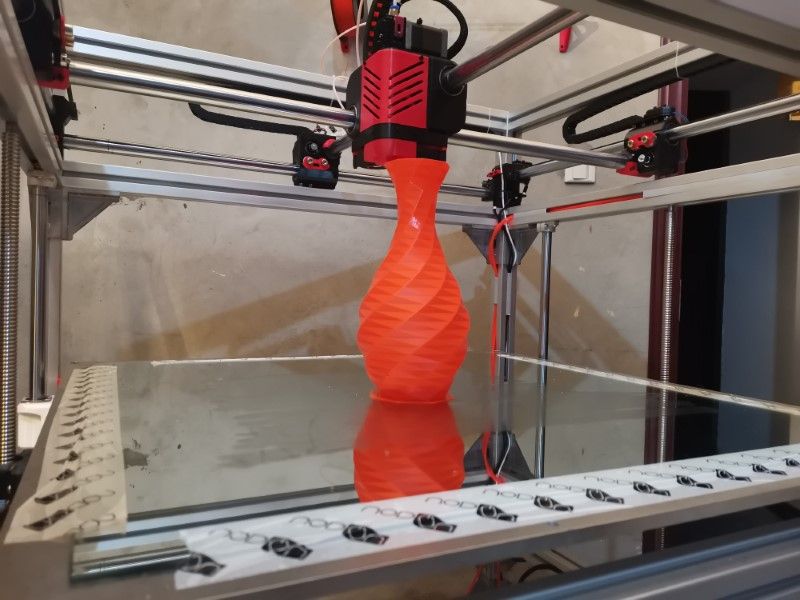
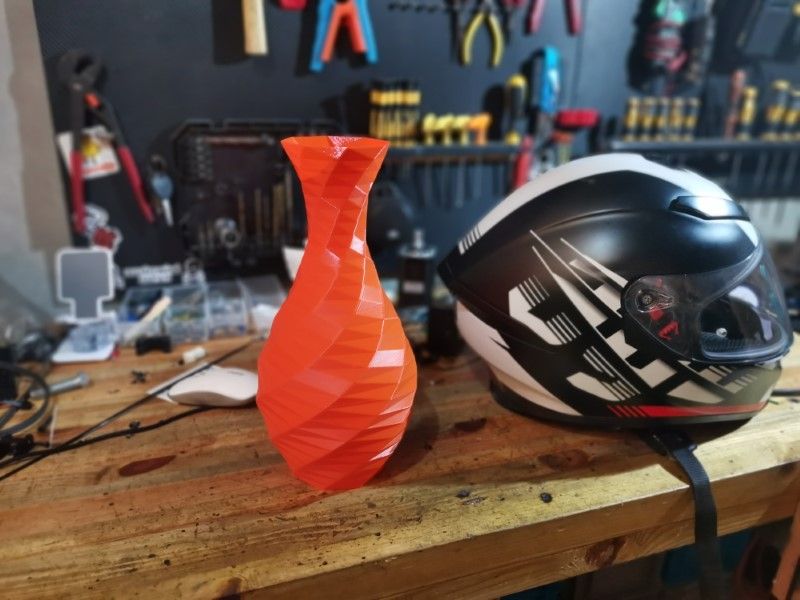
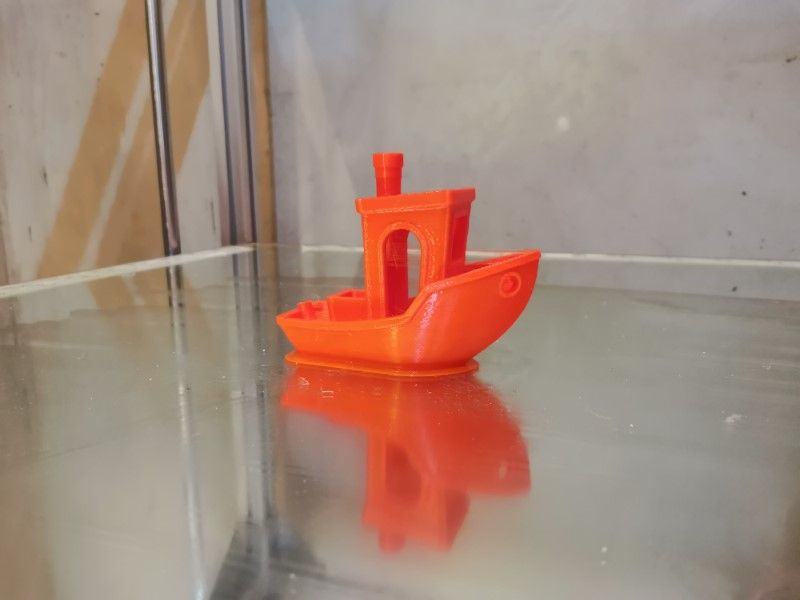
The Red one has been made with my old machine, and I just printed the orange one withthe printer I just built:
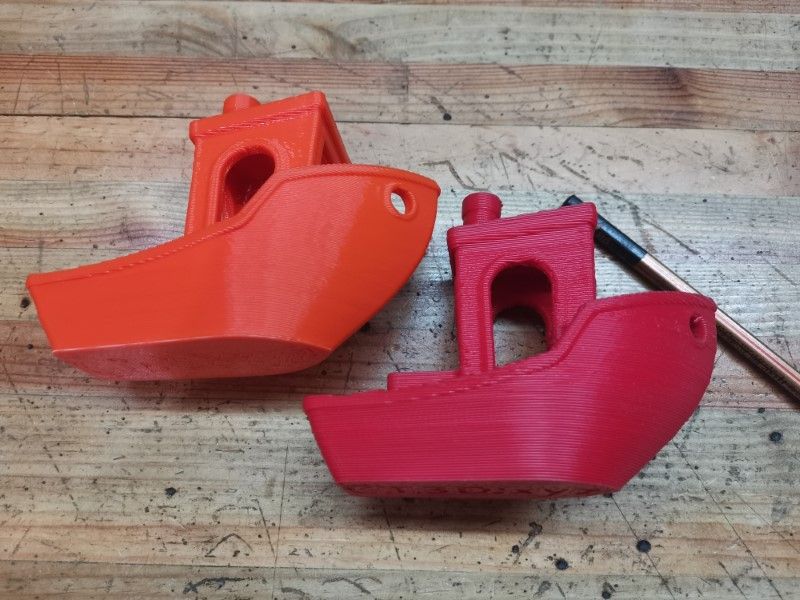
The orange one was printed with a 0.8mm nozzle at 0.4mm height per layer.
Really satisfied with how my printer works so far, and the Duet board works very well.
I'll need to experiment a little with the linear advance to get better corners and path starts, but aside from this both prints were almost flawless. -
@MrDui nice machine, sort of a super large Ultimaker! Are the X and Y linear rails tubing ( like MPCNC), or solid linear rod? Also, what size belt (looks a bit narrow for all that weight)?
If you’re concerned about belt stretch as you increase speed and acceleration, particularly as you are moving 2 motors per axis, it would be quite simple to convert your belts to ‘Everman belt drive’ eg
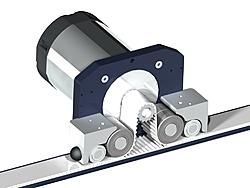
See https://www.cnczone.com/forums/linear-and-rotary-motion/59570-forum.html or for a quicker intro see https://openbuilds.com/threads/longest-x-axis.868/#post-13415Basically, attach another length of belt (using double sided tape is recommended) under the existing belt, teeth upward. The existing belt teeth will mesh the lower belt, and there will be very little belt to stretch. There are a few other things to note, see previous links. I’m planning on doing this on my CNC machine, if I ever get around to finishing it!
Ian
-
@droftarts said in BOx Large Format DIY Printer:
@MrDui nice machine, sort of a super large Ultimaker! Are the X and Y linear rails tubing ( like MPCNC), or solid linear rod? Also, what size belt (looks a bit narrow for all that weight)?
Thanks!
The tubes are industrial linear rails, they are hollow but if you take a close look at the first picture of the machine in my first post, you can see that they are really thick.If you’re concerned about belt stretch as you increase speed and acceleration, particularly as you are moving 2 motors per axis, it would be quite simple to convert your belts to ‘Everman belt drive’ eg
Ian
I've seen this done on some machines, it works well. To be honest, I'm not concerned at all by the belts. I used them on my previous machine and they worked just fine. Plus, the results I got yesterday seem really good to me, especially considering the fact that my belts weren't even tightened (I just saw that today)...
If it comes to that, I can always change for some steel reinforced ones or just go for 10mm wide. But, at least in my experience, it's not necessary and it won't make any noticeable difference. Only case I see it might make a difference would be if I went for really insane accelerations, but my guess would be that the motors will start skipping steps way before belts will become an issue.
-
@MrDui said in BOx Large Format DIY Printer:
steel reinforced ones
generally a bad idea for 3d printers using small pulleys/idlers the bend radius are small enough that the steel work hardens over time and snaps.
-
@T3P3Tony said in BOx Large Format DIY Printer:
@MrDui said in BOx Large Format DIY Printer:
steel reinforced ones
generally a bad idea for 3d printers using small pulleys/idlers the bend radius are small enough that the steel work hardens over time and snaps.
Yeah I heard about that but I never actually tried myself. I do have a few meters so maybe I should give it a shot just to see how long they'd last.
Let's say that they are good for 1000 hours, then it just becomes a regular maintenance thing, just like replacing nozzles.
It's not like they'd snap anyway, they'd just lose a tiny bit of accuracy, so there's not a big risk of trying it.
-
Ok guys so a quick update. I've stopped using the HDMI and USB cables. I really loved the idea and it was so easy to build, but it just wasn't reliable enough. I had lots of issue with the HDMI disconnecting and also sometimes some layers skipped, which led me to doubt about the reliability of the USB, though I had no proof they were the culprit.
I'm still using the USB for the endstops and filament sensor since those seemed to work just fine.So, anyway, I've redesigned many, many parts in order to fit the new wiring harness system:
First, the electronic enclosure, featuring the new plugs, two power converters (one for the watercooling pump, one other for the LED light on the print head), and also an air duct to directly cool the drivers using a blower fan :
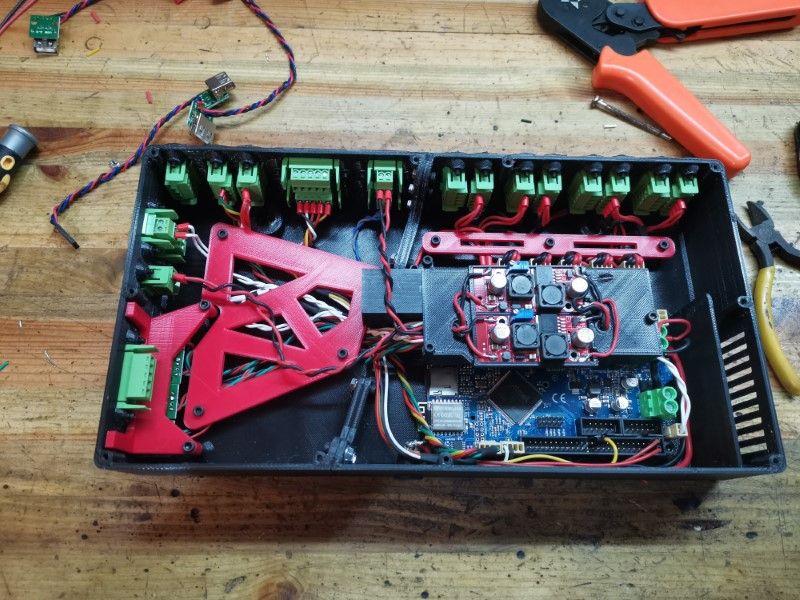

I used my lathe to machine some belt guides out of aluminum, because the belts were sometimes rubbing against the plastic:
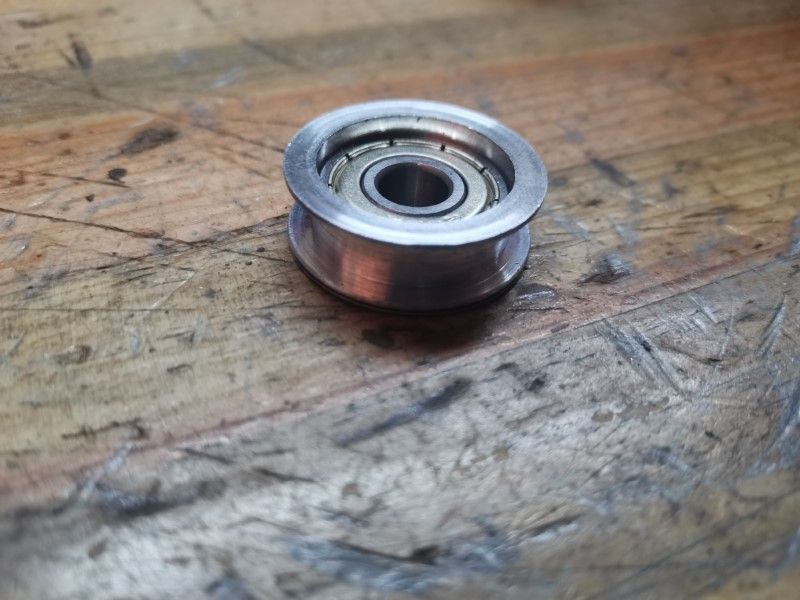
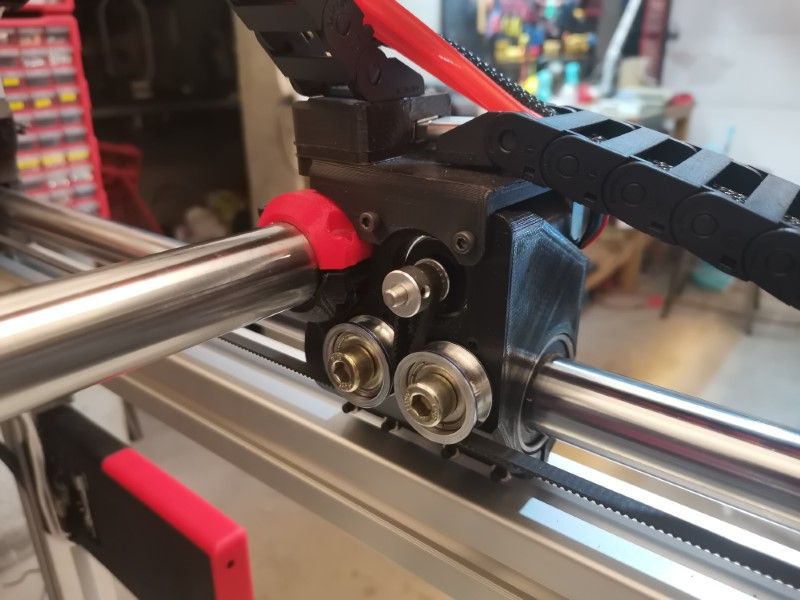
The drag chain anchor points have been redesigned for something sturdier integrating the plugs for the stepper motors, which are now wired in series instead of parallel, to get more torque. All the harness is made of silicone insulated wire, so that they are extremely flexible, thus lowering the tension on the drag chains :

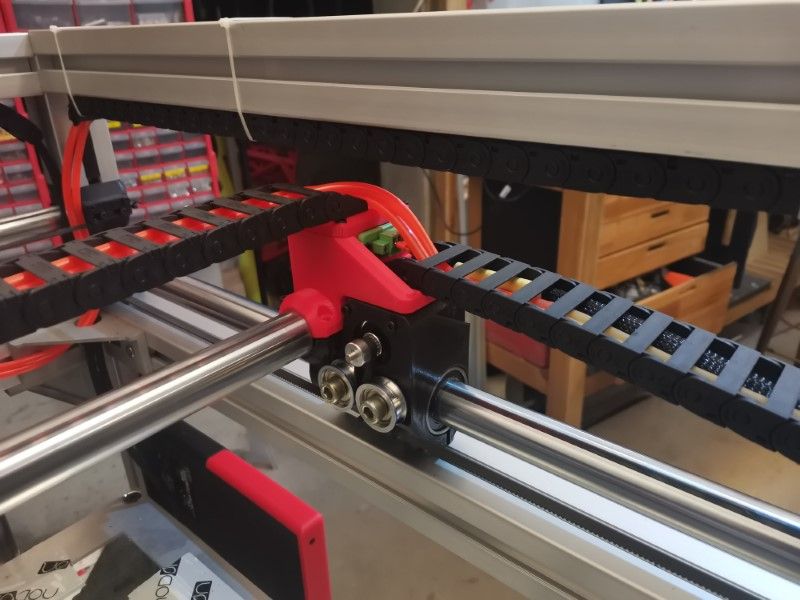
Last but not least: the print head and the carriage. Now everything fits within the carriage so that's a lot cleaner. The print tool can be dropped in the carriage in less than 2 minutes, so I can change for another tool quickly if necessary:
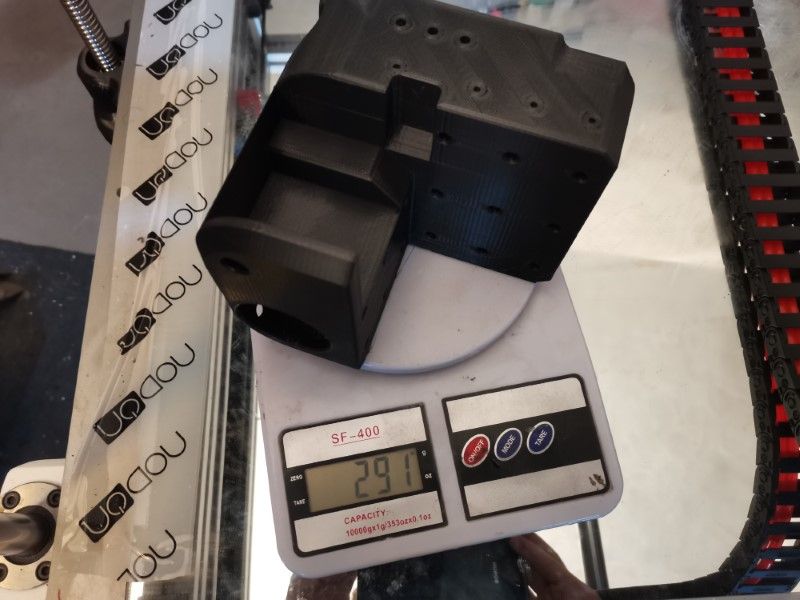
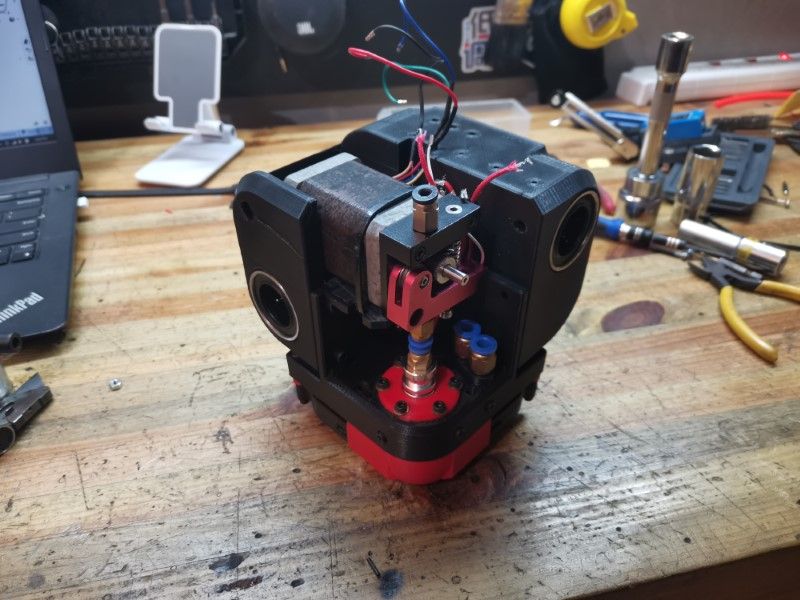
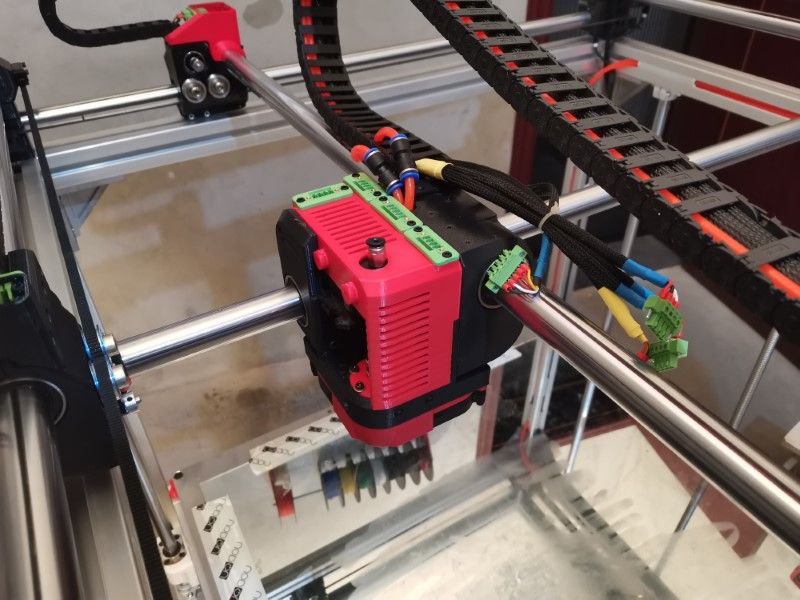
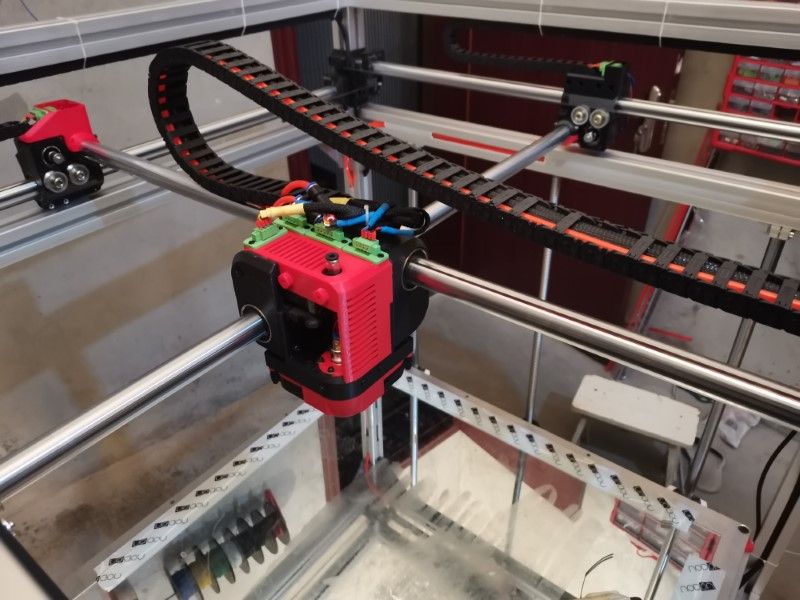
It's quite heavy, the print head weights more than 2Kg. Also the X and Y tubes are very heavy too and weight approximately 3-4 kilo each.
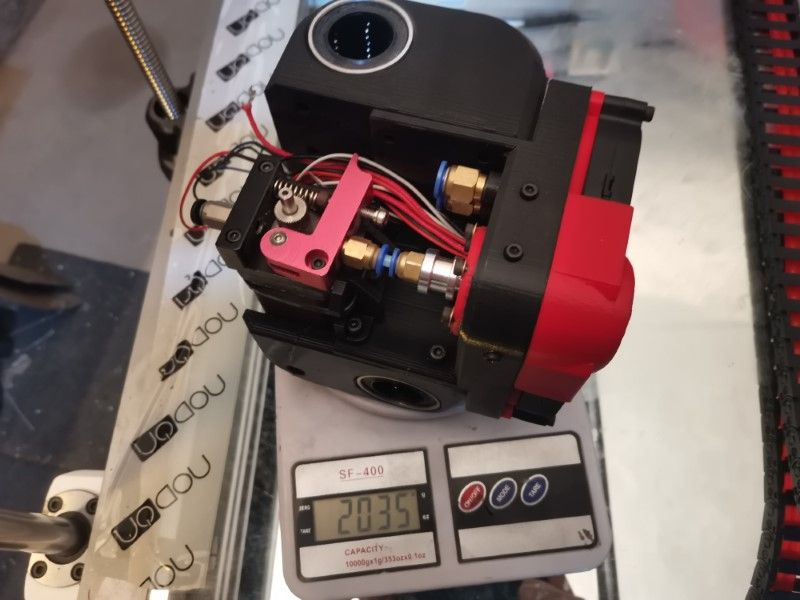
Despite all that weight, the printer is incredibly fast and responsive, I've made some tests running it at 300mm/sec and 3000mm/s2 of acceleration and it was working perfectly well with no skipped steps!
The Duet board does an amazing job, that's insane to see.
Right now I'm missing a part for the extruder so I was not able to extrude plastic, but just look at the kind of speeds I'm talking about on the following video... remember that this print head weights more than 2 kilos, the motors move it around like it weights nothing!!I'm super impressed by the Duet so far. I think I'll give a try to the Duex5 Expansion board to add at least one other Z axis, maybe two. And then later some more extruders (but I'll wait for the machine to be really stable and finished before I'll try). This board has surpassed my expectations by quite a lot, I was not expecting it to be that great.
Kudos to the team who designed it!
-
Such a nice printhead! But please get rid of that Extruder!!!!
-
@PCR said in BOx Large Format DIY Printer:
Such a nice printhead! But please get rid of that Extruder!!!!
Why?